The week-long Interpack Processes and Packaging trade fair in Germany concluded on May 14 with a visitor count that topped 175,000 from 120 countries. Show-goers had plenty to see and do, as approximately 2,700 exhibitors displayed cutting-edge packaging systems and food processing technology in 19 halls at the sold-out Düsseldorf Exhibition Center.
 More than 175,000 visitors from 120 countries filled 19 halls at Interpack looking for innovative new packaging and processing systems. They were not disappointed. The dominating themes at the fair were resource efficiency for equipment and machinery, as well as for packaging material usage, quality and safety to guarantee highly desirable and counterfeit-proof finished products – especially in such sensitive segments as food and beverage – as well as diversity and flexibility for an ever wider range and shorter product cycles. This was abundantly evident in the particularly high number of innovations presented by exhibiting companies.
More than 175,000 visitors from 120 countries filled 19 halls at Interpack looking for innovative new packaging and processing systems. They were not disappointed. The dominating themes at the fair were resource efficiency for equipment and machinery, as well as for packaging material usage, quality and safety to guarantee highly desirable and counterfeit-proof finished products – especially in such sensitive segments as food and beverage – as well as diversity and flexibility for an ever wider range and shorter product cycles. This was abundantly evident in the particularly high number of innovations presented by exhibiting companies.
With foreign visitor participation of 66%, and some 75% of the exhibitors hailing from outside of Germany, Interpack 2014 not only set a new record for itself, but also scored a top rating across all Messe Düsseldorf trade fairs.
As always, equipment suppliers to the frozen food industry were in high profile. Members of the FrozenFoodsBiz.com editorial team checked out many of them. A review of some of what they found follows.
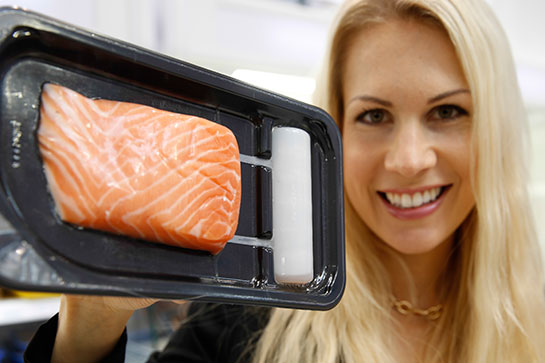 Thermoform packaging was in fine form at the Interpack Process and Packaging exhibition.
Thermoform packaging was in fine form at the Interpack Process and Packaging exhibition.
Arctic Freeze, Big Time
Varel, Germany-based Heinen Freezing GmbH & Co. Kg. managed to be at two places at one time on May 8, as representatives of the Kahl Group team exhibited at both the Interpack and the Seafood Processing Global in Brussels on that busy day. But from the 9th-14th the company’s full concentration was on opportunities at the bustling Düsseldorf venue.
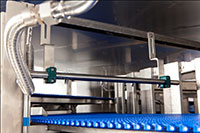 Cleaning nozzles above the belt maximize hygienic conditions in Heinen’s Arctic spiral freezers.In Belgium it could be said that the emphasis was “mini,”as Heinen showcased its smallest cooling and freezing compact system. The unit is pre-mounted fully assembled on a base frame and able to industrially freeze seafood and other products at throughputs of up to 800 kilograms per hour.
Cleaning nozzles above the belt maximize hygienic conditions in Heinen’s Arctic spiral freezers.In Belgium it could be said that the emphasis was “mini,”as Heinen showcased its smallest cooling and freezing compact system. The unit is pre-mounted fully assembled on a base frame and able to industrially freeze seafood and other products at throughputs of up to 800 kilograms per hour.
At Interpack, on the other hand, the company spotlighted its “maxi” capacity Arctic spiral system for cooling and freezing food products. The stainless steel belted freezer was not produced only to appear at the show, as it was delivered directly to a client’s baked goods factory after the fair’s conclusion.
All Heinen spiral systems are of robust design for industrial multi-shift applications, explained marketing and sales support specialist Michaela Teschner. They feature high-quality machine components, and a minimum number of moving parts assure the highest degree of reliability.
Hygienic conditions are enhanced by lining wall and ceiling panels of the insulated enclosure with stainless steel. Optionally equipped with a facile belt-cleaning unit with pump for increasing pressure-generated foam, the system can be upgraded with an extended system that cleans the entire interior in addition to the belt and conveyor.
At the end of a production shift defrosting can be carried out manually, using hot gas or electrical heating mediums. Heinen has developed a special snow blow-off system that can extend production time before defrosting is necessary. In fact, the continuously working sequential defrosting operation allows for up to 144 hours of uptime without interruption.
Heinen also produces systems for proofing, pasteurizing and storing foods. With a product portfolio of five different spiral freezers, two fluidized bed freezing models and a multistage buffer freezer system, the company offers versatile designs for different applications. Between 40 and 50 units are built on an annual basis.
In recent years the Varel factory has been especially busy filling orders placed by manufacturers in the booming baked goods sector. At the same time, the machine builder’s Arctic model has been popular with processors of fish, poultry, red meat and pizza products, while the Packfrost unit is in steady demand among makers of ice cream.
The company also provides complete, turnkey production line installation services in cooperation other equipment producers. With over 30 years of experience in installing systems at more than 500 plants around the world, Heinen engineers and support staff are proud that customers refer to them as “the freezing people.”
Innovating Since 1950
The international dynamism of Hayward, California-headquartered Heat and Control was in high gear at Interpack, where the company’s well versed crew of food processing systems experts from around the world offered advice and engaged visitors in conversation ranging from the “good vibrations” of FastBack horizontal motion conveyors to Spray Dynamics food seasoning and coating equipment, to frying and cooking systems for prepared foods, smaller footprint vacuum frying, new micro breaders, smart handling of shrimp in the production of IQF ready meals and other hot topics.
Heat and Control builds french fry and formed potato product fryer systems capable of handling up to 22.6 metric tons per hour. Additionally, it supplies complete lines including potato coating applicators, conveyors, weighers, inspection and packaging equipment.
In business since 1950, the company’s offices and production plants span the planet from the USA and Mexico to Australia, New Zealand, China, Singapore, India, Scotland, South Africa and Holland. Among its global partners are Ishida (weighing, packaging, labeling and inspection systems), CEIA (metal detectors) and Urschel (food cutting technology).
Making the Case at CPS
Stramproy, Holland-headquartered Case Packing Systems (CPS) was on the scene with a high capacity CLP Casepacker, built to automatically load products into crates, cases or trays. Its in-feed system is capable of rotating individual products, allowing for a wide variety of packed patterns.
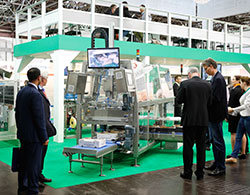 The CLP Casepacker for loading crates, cases and trays attracted a lot of visitors to the CPS stand during all seven days of the fair.When FrozenFoodsBiz visited the busy stand, Henri Veltmans, export manager, was thoroughly engaged in showing a the “ins and outs” of the versatile system to a group of potential clients gathered around the CLP Casepacker. Pieter Aquarius, managing director, was topside of the two-tier stand meeting with key customers.
The CLP Casepacker for loading crates, cases and trays attracted a lot of visitors to the CPS stand during all seven days of the fair.When FrozenFoodsBiz visited the busy stand, Henri Veltmans, export manager, was thoroughly engaged in showing a the “ins and outs” of the versatile system to a group of potential clients gathered around the CLP Casepacker. Pieter Aquarius, managing director, was topside of the two-tier stand meeting with key customers.
Joan Berkvens, sales coordinator, welcomed the editors and explained that packed products conveyed through the system are first divided into a formation creating correct packing patterns to properly and efficiently fill carriers. Thereafter, a complete layer formation moves down the line to the retract conveyor, where side compacting takes place before pick up. Next, the retract conveyor withdraws and the layer of products is placed vertically into the product carrier.
CPS is enjoying good demand for the CLP model. In fact, the unit on active duty at the Interpack was destined to be shipped to a major frozen potato processing company in the USA right after the show.
In business since 1988, CPS focuses fully on automatic case packing systems with special emphasis on flexible packages and trays. Its machines pack products more compactly than is possible by hand, and therefore achieve substantial cost savings for users.
Flexolutions from BPA
A visit to the BluePrint Automation BV (BPA) stand revealed a much larger company profile that existed during the last edition of Interpack three years ago. Since then expansion and acquisition, along with steadily rising international sales, have been major factors in the growth of the Woerden, Holland-based designer and builder of erecting machines for cartons and folded boxes, pick-and-place robots, turnkey packaging systems, wrap-around and cartoning solutions.
President Paul van der Meulen gave FrozenFoodsBiz a demonstration of the Universal Delta Robot in action. The new, modular vision guided system was developed for horizontal packing of stand up pouches, stick packs, four-side sealed pouches, sachets and pillow bags. The basic machine has two modules and packs up to 300 units per minute. It is expandable with extra modules to boost capacity, as needed.
Last year BPA acquired Culemborg, Holland-based Racupack, an established specialist in wrap-around and cartoning systems. Its Catamaran CPIII machine, on display in Düsseldorf, is designed to automatically erect, fill and close wrap-around cases, trays (lids) and RSC cases at a clip of 30 boxes per minute.
“This really brings us into a totally different field,” said Van der Meulen, “as the acquisition enables us to offer a more diverse product portfolio and provides our customers with single source, turn-key packaging solutions.”
In the frozen food sector, the president reported that the ice cream market “has become more important for us.” Indeed, BPA has earned “preferred supplier” status with a major multinational producer of frozen confectionery.
Van der Meulen, who has many years of experience in the China market, plans to devote more time to further develop prospects in the PRC. BluePrint Automation, which has an office in Hangzhou, aims to assemble equipment in China for sale domestically as well as elsewhere in East Asia.
“There are huge opportunities today in countries where not long ago the advantages of labor saving through automation were not a priority among food producers,” said the president. “Now, quality control is more important than ever, and the availability of reliable labor in some fast developing countries is not as plentiful as before.”
Meanwhile, an increase in business and orders for multi-robot lines has prompted BPA’s BluePrint Robotics division in the USA to add 18,000 square feet of workspace at a facility Longmont, Colorado. The company’s vision-guided robotics systems are designed for sophisticated picking of individual packaged and unpackaged items for loading into containers, wrappers or Horizontal Form Fill and Seal (HFFS) machines.
Good Year for Bosch
Friedbert Klefenz, president of Bosch Packaging Technology, expressed satisfaction with the quantity and quality of visitors who stopped by the Stuttgart, Germany-headquartered company’s stand.
“The interest in our technologies that make a vital contribution to global health and nutrition was enormous,” he said. “We are pleased with the high number of leads received, including many top executives and potential new customers.”
At a press conference on the day the show kicked off, Klefenz reported that the company’s sales grew by 22% in 2013 as revenues hit 1.1 billion euros – up by 200 million euros over the previous year’s performance. Well over 90% of the turnover was generated in the pharmaceutical and food sectors (52% and 46%, respectively).
Europe, by far, is Bosch’s biggest market, accounting for nearly 40% of sales in 2013. The Americas ranked second with a 27% share. North America was first in terms of regional growth, registering a 12% increase in turnover.
“We aim to continue growing strongly in established markets such as North America and Europe. But the significance of Asian markets is growing,” said Klefenz. “By the end of the decade, we intend to generate far more than a third of our sales in Asia. Africa and the Middle East are also becoming more important for us. By 2020, we intend to make almost 10% of our sales in these regions.”
Among products aimed at developing markets is Bosch’s entry-level SVI 2600 Vertical Form, Fill and Seal (VFFS) machine. Initially designed for small- and medium-size producers seeking to automate their packaging processes, it is also a cost-effective option for large manufacturers seeking to test market new products or fulfill low-volume requirements.
The equipment incorporates the same proven technology employed on higher-end baggers, such as servo-driven cross-sealing units, vacuum belts and Bosch/Beckhoff controls. The intermittent motion pillow, side gusseted and block-bottom bagger operates at 120 bags per minute.
Multivac on Fast Track
Wolfertschwenden, Germany-headquartered Multivac utilized the Interpack venue to roll out its new R 085 entry-level thermoformer, which may be used for running both flexible and rigid films. It is aimed at small- and medium-size companies keen on entering the realm of automated thermoforming packaging for the first time.
The machine can be ordered with four standard format layouts, and can be used to produce packs with inert gas as well as vacuum packs. With a thermoforming depth of up to 80mm, the R 085 provides a wide range of pack design possibilities.
The system is equipped with the IPC 06 machine control as well as the HMI 2.0 user interface with a 12.1 touch screen. It also has a quick-change feature for forming and sealing dies with proven slide-in technology, which is integrated as standard in the die design. This makes it easier to convert the machine to other formats.
Versa-Link Belt Debut
Sittingbourne, Kent, England-based Wire Belt unveiled the newly patented Vera-Link conveyor belt at the show, presenting it as one of the most durable open metal belts available for light- to medium-duty applications in the food processing industry.
Designed with Advanced Link Rod technology, the linking rods splice in as little as 30 seconds. There are no special tools or welding required, and the rods connect in the center, leaving no weak points. A lightweight alternative to heavy flat-wire belts, Versa-Link’s spacing pattern offers product support to the edge of the belt, providing strength and long belt life.
The belt design is positioned as well suited for a wide variety of applications such as breading, battering, cooling, coating and frying. Made with quality stainless steel, it is able to operate in the most demanding conditions, and is easy to clean.
The company’s Forged Edge technology eliminates catch points and sharp edges. The forged edges will not beak, snag or snap off during production, keeping lines running safely and efficiently. Versa-Link is said to offer one of the tightest transfers available, and can be easily retrofitted on existing equipment.
High-speed Metal Detection
Oldham, Lancashire, England-based Loma Systems and Lock Inspection Systems showcased SureTune IQ3+ ST next generation metal detectors at the fair. Ideally suited for high-speed food manufacturing, they address drifting on the head coil and false rejects caused by subtle variations in atmospheric temperature and product characteristics. An intelligent validation system memorizes defined rest intervals by product and the individual retailer’s code of practice.
Lock’s improved Insight system has enhanced stability, height adjustability and a robust clamping sleeve that removes the need for resin assembly. For ease of installation, there are 200 product presets and a permanent memory store for up to 8,000 data events.
Check Out New Checkweighers
Giessen, Germany-headquartered Mettler-Toldeo Garvens launched the C3000 System at Interpack. Described as “a new generation of checkweighers,” it covers a weighing range of up to 10 kilograms and allows food manufacturers to inspect as many as 600 products per minute.
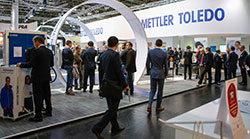 Mettler-Toledo showcased the next generation C3000 System at Interpack, alongside its new ATEX-certified XS3 conveyor belt checkweigher.“As consumer demand for more convenience products continues to increase, the global marketplace has become increasingly competitive, with food manufacturers under constant pressure to quickly pack multiple goods,” said Kerstin Bernhart, head of marketing and product management for the company. “Manufacturers continually face challenges to produce high quality, safe products at the correct weight, at a low cost per package. Our new generation of checkweighers guarantees supreme levels of weighing accuracy at high throughput production rates.”
Mettler-Toledo showcased the next generation C3000 System at Interpack, alongside its new ATEX-certified XS3 conveyor belt checkweigher.“As consumer demand for more convenience products continues to increase, the global marketplace has become increasingly competitive, with food manufacturers under constant pressure to quickly pack multiple goods,” said Kerstin Bernhart, head of marketing and product management for the company. “Manufacturers continually face challenges to produce high quality, safe products at the correct weight, at a low cost per package. Our new generation of checkweighers guarantees supreme levels of weighing accuracy at high throughput production rates.”
The increased stability of the C3000 System provides protection against vibrations caused by other production line machinery and is said to offer enhanced throughput performance of up to 33%, with higher weighing accuracy. Its modular design allows for a variety of configurations, and manufacturers can choose from a range of optional product inspection technology combinations such as metal detection (CM Model), x-ray inspection (CX model) or vision inspection (CV model).
The flexibility of the technology allows processing lines to run at optimal speeds, inspecting a variety of products at correct frequency levels to ensure the best level of sensitivity is reached. Metal detection sensitivity options incorporate two tuned frequency ranges respectively, 100/300/800 Hz and 25/100/300 Hz, for optimum capabilities. A single Human Machine Interface (HMI) seamlessly controls the checkweighing and metal detection technology, enhancing overall equipment effectiveness by reducing programming time and the risk of operational error.
The systems also integrate centralized inventory management technology, enabling faster, more efficient reporting on product changeovers and the rejection of defective products.
Breakthrough Generation
Esslingen am Neckar, Germany-based Festo AG’s valve terminal concept CPX/MPA has enabled the Milano, Italy-headquartered Cama Group to pave the way for a completely new machine generation, the results of which were on display for all to see at Interpack.
“The positive effect of CPX/MPA is that the space requirements of our new packaging machines have been reduced by approximately a third,” said Stefano Rini, head of research and development at Cama. “This is one of the reasons why it is called Cama’s Breakthrough Generation.”
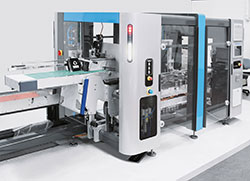 An example of the Festo-Cama collaboration for new “Breakthrough Generation Machines” is this “CL” cartoner. Operating on a side-loading principle, it takes up significantly less space on the factory floor. In three steps, cartons are opened, filled with many different kinds of products, and then closed.This new series of machines highlights Cama’s renowned lean design of secondary packaging equipment and robots. “This machine generation will create entirely new opportunities for growth for us,” predicted Rini.
An example of the Festo-Cama collaboration for new “Breakthrough Generation Machines” is this “CL” cartoner. Operating on a side-loading principle, it takes up significantly less space on the factory floor. In three steps, cartons are opened, filled with many different kinds of products, and then closed.This new series of machines highlights Cama’s renowned lean design of secondary packaging equipment and robots. “This machine generation will create entirely new opportunities for growth for us,” predicted Rini.
One characteristic feature of conventional machines is the large control cabinet outside the main structure. The controllers within the cabinet are connected to drives, sensors and valves by a multiplicity of cables and lengths of tubing several meters long.
With the Breakthrough Generation, Cama completely restyled its machines. This allows machine footprint reduction by integrating the control cabinets with electrical and pneumatic components into the machine pedestal’s angles. Such a compact design helps to minimize cabling and makes it easier to place utility devices right where they are needed, and thus make them more easily accessible.
“Significantly fewer and shorter cables and tubes to be connected simplify and shorten installation. This is a further distinguishing feature,” explained the machine builder as he described the gain in efficiency.
“What is more, the CPX offers diagnostic functions. This makes it easy for us to meet the demands of large branded-product manufacturers, for example for preventive maintenance,” continued Rini.
Attention has also been paid to machine safety. The Festo soft-start and exhaust valve MS6-SV is used to exhaust the system. It provides reliable protection against unexpected start-up and has an exhaust capacity 1.5 times its pressurization capacity.
Cama has also introduced the CL 175, an extremely flexible side-loading cartoning machine. It has been completely redesigned, both in layout and functionality. The equipment can load flow-wraps, pouches, bags, thermoformed trays, blister packs and more into pre-glued cartons.
The side-loading unit loads products into cartons with an intermittent-continuous motion. This handling unit consists mainly of a Festo electric axis EGC for a precise approach to intermediate positions and a pneumatic mini slide DGSL. EGC helped to reduce the mounting time by 30% compared to the previous self-made electrical axis. The use of both pneumatic and electrical drive technologies allows high precision to be obtained together with a high load capacity.
Next, the cartons move toward the final closure station. It can work in continuous or intermittent mode. Finally, the cartons get onto the outfeed conveyor.
Fine Forming from Taiwan
The SD-97W automatic encrusting and forming machine from New Taipei City, Taiwan-headquartered Anko Food Machine Co., Ltd. attracted plenty of attention at the show. The system uses a shutter mold to form two colors or a solid color casing, dough-based shell or pastry to be stuffed with filling. This is accomplished by simply changing the forming mold and filling facilities, such as meat bun, coxinha, mammoul, meat pie, kubba, potato bread, rice cake, mochi, marzipan, croquette, crystal dumpling, moon cake, filled focaccia bread and cylindrically shaped products.
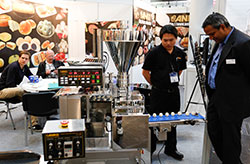 Taiwan’s Anko Food Machine Co., Ltd. impressed show-goes with its SD-97W model automatic encrusting and forming equipment.Fillings can range from bean or peanut paste to powder, minced meat, or sesame paste, as well as whole peanut pieces, macadamia, pistachio or other kinds of nuts, bird egg, or small fruits and berries.
Taiwan’s Anko Food Machine Co., Ltd. impressed show-goes with its SD-97W model automatic encrusting and forming equipment.Fillings can range from bean or peanut paste to powder, minced meat, or sesame paste, as well as whole peanut pieces, macadamia, pistachio or other kinds of nuts, bird egg, or small fruits and berries.
Five programmable memories may be utilized, as well as various synchronized functions. Dough and filling volume may be increased simultaneously, and conveyor speeds can be timer-controlled.
Headed up CEO Robert Ou-Young, the company was established in 1978, initially to exclusively produce automatic seed sprouters. It evolved over time, and today Anko offers a full range of high-tech food processing machinery including automatic spring roll, dumpling, ravioli, samosa, shiu mai, won ton, empanada and other kinds of ethnic food manufacturing equipment.
More details about all the machinery and systems profiled in this review may be obtained from the exhibiting companies directly. Meanwhile, the next Interpack will be held in May of 2017. While exact dates have not yet been determined, when announced they will be posted at the organizer’s website: www.messe-duesseldorf.de or www.interpack.de





